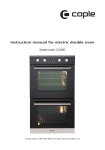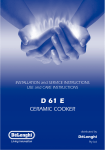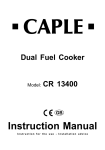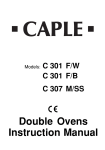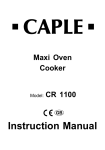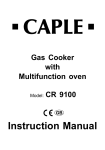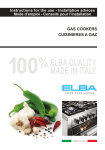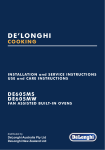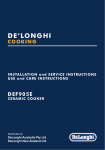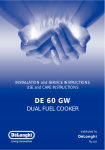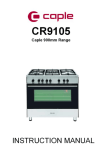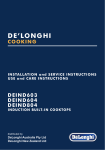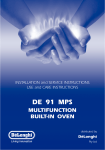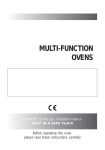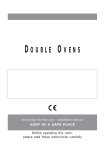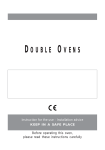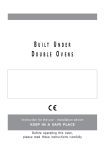Download DeLonghi D 61 E Cooktop User Manual
Transcript
D E ’LON GHI COOKING INSTALLATION and SERVICE INSTRUCTIONS USE and CARE INSTRUCTIONS DE608MLH DE608MRH MULTI F UN C T IO N B U ILT-IN OVE NS W I TH S I DE O P E N IN G D OO R distributed by DeLonghi Australia Pty Ltd DeLonghi New Zealand Ltd Dear Customer, Thank you for having purchased and given your preference to our product. The safety precautions and recommendations reported below are for your own safety and that of others. They will also provide a means by which to make full use of the features offered by your appliance. Please keep this booklet in a safe place. It may be useful in future, either to yourself or to others in the event that doubts should arise relating to its operation. This appliance must be used only for the task it has explicitly been designed for, that is for cooking foodstuffs. Any other form of usage is to be considered as inappropriate and therefore dangerous. The manufacturer declines all responsibility in the event of damage caused by improper, incorrect or illogical use of the appliance or be faulty installation. This appliance has been designed and constructed in accordance with the following codes and specifications: AS/NZS 60335.1 General Requirements for Domestic electrical appliances AS/NZS 60335.2.6 Particular Requirements for Domestic electrical cooking appliances AS/NZS CISPR 14.1 Electromagnetic Compatibility Requirements. PRODUCT LABEL 2 Important: This appliance is designed and manufactured solely for the cooking of domestic (household) food and is not suitable for any non domestic application and therefore should not be used in a commercial environment. The appliance guarantee will be void if the appliance is used within a non domestic environment i.e. a semi commercial, commercial or communal environment. FIRST USE OF THE OVEN It is advised to follow these instructions: ■■ Furnish the interior of the oven as described at chapters “USE AND CARE” and “CLEANING AND MAINTENANCE”. ■■ Switch on the empty oven on max to eliminate grease from the heating elements. ■■ Let the oven cool down and clean the interior of the oven with a cloth soaked in water and neutral detergent, then dry carefully. IMPORTANT PRECAUTIONS AND RECOMMENDATIONS FOR USE OF ELECTRICAL APPLIANCES Use of any electrical appliance implies the necessity to follow a series of fundamental rules. In particular: ■■ Never touch the appliance with wet hands or feet. ■■ Do not operate the appliance barefooted. ■■ The appliance is not intended for use by young children or infirm persons without supervision. ■■ Young children should be supervised to ensure they do not play with the appliance. The manufacturer cannot be held responsible for any damages caused by improper, incorrect or illogical use of the appliance. 3 IMPORTANT PRECAUTIONS AND RECOMMENDATIONS After having unpacked the appliance, check to ensure that it is not damaged and that the oven door closes correctly. In case of doubt, do not use it and consult your supplier or a professionally qualified technician. Packing elements (i.e. plastic bags, polystyrene foam, nails, packing straps, etc.) should not be left around within easy reach of children, as these may cause serious injuries. ■■ Some appliances are supplied with a protective film on steel and aluminium parts. This film must be removed before using the appliance. ■■ Do not attempt to modify the technical characteristics of the appliance as this may become dangerous to use. ■■ Do not carry out cleaning or maintenance operations on the appliance without having previously disconnected it from the electric power supply. ■■ After use, ensure that the knobs are in the off position. ■■ Keep children away from the appliance when it is in use. ■■ WARNING: Accessible parts will become hot when in use. To avoid burns and scalds, young children should be kept away. ■■ Young children should be supervised to ensure that they do not play with the appliance. ■■ Children, or persons with a disability which limits their ability to use the appliance, should have a responsible person to instruct them in its use. The instructor should be satisfied that they can use the appliance without danger to themselves or their surroundings. ■■ During and after use of the appliance, certain parts will become very hot. Do not touch hot parts. Care should be taken to avoid touching heating elements inside the oven. ■■ Make sure that electrical cables connecting other appliances in the proximity of the oven cannot become entrapped in the oven door. ■■ WARNING: When correctly installed, your product meets all safety requirements laid down for this type of product category. 4 ■■ ■■ ■■ ■■ ■■ ■■ ■■ ■■ ■■ ■■ ■■ ■■ ■■ However special care should be taken around the rear or the underneath of the appliance as these areas are not designed or intended to be touched and may contain sharp or rough edges, that may cause injury. Do not line the oven walls with aluminium foil. Do not place baking trays or the drip tray on the base of the oven chamber. Fire risk! Do not store flammable material in the oven. Always use oven gloves when removing the shelves and food trays from the oven whilst hot. Do not hang towels, dishcloths or other items on the appliance or its handle – as this could be a fire hazard. Clean the oven regularly and do not allow fat or oils to build up in the oven base or tray. Remove spillages as soon as they occur. Do not stand on the open oven door. Always stand back from the appliance when opening the oven door to allow steam and hot air to escape before removing the food. Safe food handling: Leave food in the oven for as short a time as possible before and after cooking. This is to avoid contamination by organisms which may cause food poisoning. Take particular care during warmer weather. The manufacturer declines all liability for injury to persons or damage to property caused by incorrect or improper use of the appliance. WARNING: Taking care NOT to lift the oven by the door handle. IMPORTANT NOTE: This appliance shall not be used as a space heater, especially if installed in marine craft or caravans. Do not operate your appliance by means of an external timer or separate remote-control system. This appliance is for domestic use only. 5 INSTALLATION CAUTION: ■■ ■■ ■■ ■■ ■■ This appliance must be installed in accordance with these installation instructions. This appliance shall only be serviced by authorised personnel. This appliance is to be installed only by an authorised person in compliance with the current electrical regulations and in observation of the instructions supplied by the manufacturer. Failure to comply with this condition will render the guarantee invalid. Incorrect installation, for which the manufacturer accepts no responsibility, may cause personal injury of damage. Always disconnect the appliance from mains power supply before carrying out any maintenance operations or repairs. FITTING REQUIREMENTS ■■ ■■ ■■ ■■ ■■ ■■ ■■ ■■ ■■ ■■ ■■ The oven can be fitted in standard units, 60 cm width and depth. Installation requires a compartment as illustrated in figures 1a and 2a. Fitting the oven into a base: Arrangements should be made for an adequate supply of the air to the oven to avoid overheating (fig. 1b). Fitting the oven into a column: It is necessary that the oven is provided with a chimney as per fig. 2b. If the column unit reaches the ceiling an outlet must be provided through which air can flow to the outside On the lower side, the oven must lay on supports standing the oven weight. Remember the housing should not be free standing but be secured to the wall and/or adjacent fittings. We would point out that the adhesive which bonds the plastic laminate to the furniture must withstand temperatures not less than 150° C to avoid delamination. The walls of the units must be capable of resisting temperatures of 75 °C above room temperature. Do not seal the oven into the cabinetry with silicone or glue; this makes future servicing difficult. Delonghi will not cover the costs of removing the oven, or of damage caused by this removal. The walls surrounding the oven must be made of heat-resistant material. WARNING: Taking care NOT to lift the oven by the door handle. WARNING When correctly installed, your product meets all safety requirements laid down for this type of product category. However special care should be taken around the rear or the underneath of the appliance as these areas are not designed or intended to be touched and may contain sharp or rough edges, that may cause injury. IMPORTANT Some environmental factors and cooking habits can cause condensation in and around the oven during use. To protect surrounding cabinetry from possible damage caused by frequent or excessive condensation, we recommend moisture-proofing the oven cavity. 6 Figure 1a Figure 1b 600 560 min 591 536 in 594 0m 55 0 54 594 20 Figure 2a Figure 2b 50 mm 50 585 560 50 550 7 FIXING THE OVEN Introduce the oven into the furniture opening and fix it with 4 screws (not supplied) as figure 3. It is essential that the oven rests on a surface which will support its weight, as the screw fixing is only complementary. Note It is essential that when installing your oven adequate air circulation is allowed for within the installation. See figures 1a, 1b, 2a, 2b. Inadequate air circulation may greatly impair the performance of your oven and may effect adjacent cabinets due to an increase in temperature. Caution! Do not lift this oven by the door handle. Adjust the hinges of furniture doors adjacent to the oven to allow a 4-5 mm gap between the furniture door and the oven frame. Figure 3 Depending on the model, the oven door is hinged either on the left or the right. 8 Figure 4 OVEN DOOR LOWER TRIM AIR FLOW IMPORTANT: Please take extra care not to damage the lower trim of the oven. Ensure the oven sits on wooden blocks or similar supports when it is removed from the carton as shown in above diagram. This will prevent any damage to the lower trim. Should the lower trim become damaged, straighten the trim and ensure the oven door opens fully without obstruction from the lower trim. After installation check the lower trim is still undamaged. The space between the bottom of the door & the lower trim is important to allow proper air circulation into the oven. The oven door should be opened slowly to it’s fully open position ensuring there is adequate clearance between the bottom of the door and the lower trim. The manufacturer does not accept responsibility for any damage to the oven resulting from incorrect installation. 9 ELECTRICAL REQUIREMENTS ■■ The appliance must be connected to the mains checking that the voltage corresponds to the value given in the rating plate and that the electrical cable sections can withstand the load specified on the plate. ■■ A suitable isolating switch providing full disconnection from the mains power supply shall be incorporated in the permanent wiring, mounted and positioned to comply with the local wiring rules and regulations. The isolating switch must be of an approved type and provide a 3 mm air gap contact separation in all poles (or in all active [phase] conductors if the local wiring rules allow for this variation of the requirements). ■■ The isolating switch shall be easily accessible to the customer with the oven installed. ■■ The power supply cable must not touch the hot parts and must be positioned so that it does not exceed 75°C above ambient. ■■ The oven is supplied without a power supply plug and therefore if you are not connecting directly to the mains, a standardized plug suitable for the load must be fitted. ■■ The plug must be connected to an earthed socket in compliance with safety standards. ■■ To connect the appliance to the mains electricity supply, do not use adapters, reducers or branching devices as they can cause overheating and burning. ■■ Once the appliance has been installed, the switch or socket must always be accessible. ■■ If the supply cord is damaged it must be replaced by the manufacturer or it’s Service Agent or a similarly qualified person in order to avoid a hazard. N.B. The connection of the appliance to earth is mandatory. If the installation requires alterations to the domestic electrical system call a qualified electrician. He should also check that the domestic electrical system is suitable for the power drawn by the appliance. Replacing the power cord must be done by a qualified electrician in accordance with the instructions supplied by the manufacturer and in compliance with established electrical regulations. 10 REPLACING THE POWER SUPPLY CABLE Important! This appliance must be connected to the electricity supply only by an authorised person. To connect the supply cable: ■■ Unhook the terminal board cover by inserting a screwdriver into the two hooks “A” (fig. 5). ■■ Open the cable gland by unscrewing screw “F” (fig. 6), unscrew the terminal screws and remove the cable. ■■ The new supply cable, of suitable type and section, is connected to the terminal board following the diagram fig. 7. ■■ Close and hook again the terminal board cover. N.B. The earth conductor must be left about 3 cm longer than the others. VOLTAGE AND POWER CONSUMPTION 220-240 V ac 2350 W (10.21 A) Figure 5 FEEDER CABLE SECTION TYPE H05RR-F 3 x 1,5 mm2 (*) (**) (*) Connection possible with plug and outlet (**) Connection with wall box connection. A Figure 6 Figure 7 220 - 240 V F L1 N (L2) E 11 ELECTRIC DIAGRAM Figure 8 S1 N/7 F1 1 1a 2a TL1 3a 1 2 3 4a 4 5a 5 6a 7a 6 7 8a 8 9a 9 10a 10 11a 11 1a PR LF LF1 CF CIR C TL G V S T M 12 L N L/8 S2 TM ELECTRIC DIAGRAM KEY F1 Oven switch TM Oven thermostat LF/LF1 Oven lamps PROven programmer CFCooling fan motor V Oven fan motor C Oven top element G Oven grill element S Oven bottom element CIR Oven circular element TLThermal overload TL1 Cooling fan motor thermal overload S1Thermostat pilot lamp S2Line pilot lamp M Terminal block T Earth connection 13 USE AND CARE CAUTION: ■■ This appliance must be used only for the task it has explicitly been designed for, that is for domestic cooking of foodstuffs. Any other form of usage is to be considered as inappropriate and therefore dangerous. ■■ Do NOT place combustible materials or products on this appliance at any time. USING THE OVEN FOR THE FIRST TIME Operate as follows: ■■ Assemble the wire racks on the oven walls using the 2 screws interposing the catalytic panels “A” with the arrow up (fig. 9a). The catalytic panel with the hole for the side oven lamp must be positioned on the left oven wall. DO NOT INTERPOSE THE CATALYTIC PANEL WITHOUT THE HOLE ON THE LEFT OVEN WALL. ■■ Slide in the grease filter on the back of the oven as in fig. 10. ■■ Slide into the guides, the shelf and the tray (fig. 9b). The rack must be fitted so that the safety notch, which stops it sliding out, faces the inside of the oven; the guard rail shall be at the back. The tray must be fitted so that the safety notch, which stops it sliding out, faces the inside of the oven. ■■ To eliminate traces of grease in manufacture it is necessary to preheat the oven at the maximum temperature: • For 60 minutes in the position, for position and for 30 minutes in the position. another 15 minutes in the ■■ Unscrew the fixing screws and slide off the wire racks and the catalytic liners to the oven wall as in fig. 9a. The grill is secured to the rear wall of the oven on a hinge system that allows it to be lowered to allow proper access when cleaning the oven ceiling (see next chapter TILTING GRILL). ■■ Let the oven cool down, switch off the electrical supply, then clean the inside of the oven with a cloth soaked in water and neutral detergent and dry thoroughly. 14 Figure 9a A A Figure 9b Stop notch Guard rail Stop notch GREASE FILTER Figure 10 ■■ A special screen is provided at the back of the oven to catch grease particles, mainly when meat is being roasted (fig. 10). ■■ Clean the filter after any cooking! The grease filter can be removed for cleaning and should be washed regularly in hot soapy water (fig. 10). ■■ Always dry the filter properly before fitting it back into the oven. CAUTION: When baking pastry etc. this filter should be removed. TILTING GRILL ■■ The grill is secured to the rear wall of the oven on a hinge system that allows it to be lowered to allow proper access when cleaning the oven ceiling (fig. 12). ■■ To lower the grill element: use a flat-head screwdriver or a small coin to loosen the element fixing screw (fig. 11). ■■ When you have finished cleaning the oven ceiling, raise the grill element and screw the element fixing screw back onto the stud. Make sure that the fixing screw is tightened and the element is held securely in place. ■■ The grill element itself is self-cleaning. Fixing screw Stud Figure 11 Figure 12 15 CONTROL PANEL Figure 13 4 1 5 2 3 Controls description 1. Oven temperature control knob 2. Digital electronic programmer 3. Function selector control knob Pilot lamps 4. Oven temperature indicator light 5. Power on indicator light Please note: Your appliance has been fitted with a cooling fan to achieve optimum efficiency of the controls and to ensure lower surface temperatures are maintained. The cooling fan motor switches ON/OFF depending on temperature. Depending on cooking temperatures and times, the cooling fan may run on even after the appliance oven has been switched off. The duration of this time is dependent on previous cooking temperature and duration. 16 USING THE PRESS-AND-TURN CONTROL KNOBS The control knobs are flush-mounted in the control panel. Use them as follows: a. Press lightly on the knob (figure 14-A); b. The knob will extend outwards as illustrated in figure 14-B. c. Turn the knob to the required position (figure 14-C). d. When you have finished cooking, turn the knob back to the “0” (off) position and press it (figure 14-D) so that it stays flush with the control panel again (figure 14-F). IMPORTANT: Never press down the knob when it is not in the “0” (off) position (figure 14-E). Figure 14 Fig. A Fig. B Fig. C Fig. D Fig. E Fig. F 17 COOKING WITH MULTIFUNCTION OVEN Attention: The oven door becomes very hot during operation. Keep children away. GENERAL FEATURES As its name indicates, this is an oven that presents particular features from an operational point of view. In fact, it is possible to insert 7 different programs to satisfy every cooking need. The 7 positions, thermostatically controlled, are obtained by 4 heating elements which are: ■■ Bottom element 1300 W (@230V) ■■ Top element 1000 W (@230V) ■■ Grill element 2000 W (@230V) ■■ Circular element 2200 W (@230V) OPERATING PRINCIPLES Heating and cooking in the MULTIFUNCTION oven are obtained in the following ways: a. by normal convection The heat is produced by the upper and lower heating elements. b. by forced convection A fan sucks in the air contained in the oven muffle, which sends it through the circular heating element and then sends it back through the muffle. Before the hot air is sucked back again by the fan to repeat the described cycle, it envelops the food in the oven, provoking a complete and rapid cooking. It is possible to cook several dishes simultaneously. c. by semi-forced convection The heat produced by the upper and lower heating elements is distributed throughout the oven by the fan. d. by radiation The heat is irradiated by the infra red grill element. e. by radiation and ventilation The irradiated heat from the infra red grill element is distributed throughout the oven by the fan. f. by ventilation The food is defrosted by using the fan only function without heat. WARNING: The door is hot, use the handle. During use the appliance becomes hot. Care should be taken to avoid touching heating elements inside the oven. 18 Figure 15 Figure 16 THERMOSTAT KNOB To turn on the heating elements of the oven, set function selector knob to the required position and the thermostat knob to the desired temperature. To set the temperature, turn the thermostat control knob indicator mark to the required temperature. The elements will turn on or off automatically which is determined by the thermostat. The operation of the heating elements is signalled by a light placed close to the knob. FUNCTION SELECTOR KNOB Rotate the knob clockwise to set the oven for one of the following functions. OVEN LIGHT By turning the knob onto this setting we light the oven cavity. The oven remains alight while any of the functions is on. TRADITIONAL CONVECTION COOKING The upper and lower heating elements are switched on. The heat is diffused by natural convection and the temperature must be regulated between 50°C and the maximum position with the thermostat knob. It is necessary to preheat the oven before introducing the foods to be cooked. Recommended for: For foods which require the same cooking temperature both internally and externally, i. e. roasts, spare ribs, meringue, etc. 19 GRILLING The infra-red heating element is switched on. The heat is diffused by radiation. Use with the oven door closed and the thermostat knob must be regulated between 50°C and 225°C maximum. For correct use see chapter “USE OF THE GRILL”. Always grill with the oven door closed. Recommended for: Intense grilling, browning, cooking au gratin and toasting etc. DEFROSTING FROZEN FOODS Only the oven fan is on. To be used with the thermostat knob on “0” because the other positions have no effect. The defrosting is done by simple ventilation without heat. Recommended for: To rapidly defrost frozen foods; 1 kilogram requires about one hour. The defrosting times vary according to the quantity and type of foods to be defrosted. HOT AIR COOKING The circular element and the fan are on. The heat is diffused by forced convection and the temperature must be regulated between 50°C and the maximum position with the thermostat knob. It is not necessary to preheat the oven. Recommended for: For foods that must be well done on the outside and tender or rare on the inside, i.e. lasagna, lamb, roast beef, whole fish, etc. VENTILATED GRILL COOKING The infra-red grill and the fan are on. The heat is mainly diffused by radiation and the fan then distributes it throughout the oven. Use with the oven door closed and the thermostat knob must be regulated between 50°C and 220°C maximum. It is necessary to preheat the oven for about 5 minutes. For correct use see chapter “GRILLING AND COOKING AU GRATIN”. Always grill with the oven door closed. Recommended for: For grill cooking when a fast outside browning is necessary to keep the juices in, i. e. veal steak, steak, hamburger, etc. 20 MAINTAINING TEMPERATURE AFTER COOKING OR SLOWLY HEATING FOODS The upper element and the circular element connected in series, are switched on; also the fan is on. The heat is diffused by forced convection with the most heat being produced by the upper element. The temperature must be regulated between 50°C and 140°C with the thermostat knob. Recommended for: To keep foods hot after cooking. To slowly heat already cooked foods. CONVECTION COOKING WITH VENTILATION The upper and lower heating elements and the fan turn on. The heat coming from the top and bottom is diffused by forced convection. The temperature must be regulated between 50°C and the maximum position with the thermostat knob. Recommended for: For foods of large volume and quantity which require the same internal and external degree of cooking; for ie: rolled roasts, turkey, legs, cakes, etc. COOKING ADVICE The external parts of the appliance become hot during operation. Keep children well out of reach. OVEN COOKING Before introducing the food, preheat the oven to the desired temperature. For a correct preheating operation, it is advisable to remove the tray from the oven and introduce it together with the food, when the oven has reached the desired temperature. Check the cooking time and turn off the oven 5 minutes before the theoretical time to recuperate the stored heat. STERILIZATION Sterilization of foods to be conserved, in full and hermetically sealed jars, is done in the following way: . Set the switch to position Set the thermostat knob to position 185°C and preheat the oven. Fill the dripping pan with hot water. Set the jars onto the dripping pan making sure they do not touch each other and the door and set the thermostat knob to position 135°C. When sterilization has begun, that is, when the contents of the jars start to bubble, turn off the oven and let cool. a. b. c. d. REGENERATION Set the switch to position and the thermostat knob to position 150°C. Bread becomes fragrant again if wet with a few drops of water and put into the oven for about 10 minutes at the highest temperature. 21 SIMULTANEOUS COOKING OF DIFFERENT FOODS The MULTIFUNCTION oven set on position or gives simultaneous heterogeneous cooking of different foods. Different foods such as fish, cake and meat can be cooked together without mixing the smells and flavours. This is possible since the fats and vapors are oxidized while passing through the electrical element and therefore are not deposited onto the foods. The only precautions to follow are: ■■ The cooking temperatures of the different foods must be as close to as possible, with a maximum difference of 20- 25°C. ■■ The introduction of the different dishes in the oven must be done at different times in relation to the cooking times of each one. The time and energy saved with this type of cooking is obvious. ROASTING To obtain classical roasting, it is necessary to remember: ■■ that it is advisable to maintain a temperature between 180 and 200°C. ■■ that the cooking time depends on the quantity and the type of foods. USE OF THE GRILL Preheat the oven for about 5 minutes. Introduce the food to be cooked, positioning the rack as close to the grill as possible. The dripping pan should be placed under the rack to catch the cooking juices and fats. Grilling with the oven door closed. Do not grill for longer than 30 minutes at any one time. ATTENTION: the oven door becomes very hot during operation. Keep children away. GRILLING AND COOKING “AU GRATIN” Grilling may be done using the grill+fan setting , in this setting the hot air completely surrounds the food that is to be cooked, to give a more even and rapid cooking process. Set the temperature knob between 50°C and 220°C maximum, preheat the oven, then simply place the food on the grid. Close the door until grilling is complete. Adding a few dabs of butter before the end of the cooking time gives the golden “au gratin” effect. Grilling with the oven door closed. Do not grill for longer than 30 minutes at any one time. ATTENTION: the oven door becomes very hot during operation. Keep children away. 22 RECOMMENDED COOKING TEMPERATURE Food °C °F Gas Mark Shelf Position* Cooking Time (approx) 190 375 5 2 or 3 20-25 mins CAKES Victoria sandwich Small cakes/buns 190 375 5 1 and 2 15-20 mins Maidera cake 180 350 4 2 or 3 20 mins Fruit cake 170 325 3 3 13/4 hours Rich fruit cake 150 300 2 3 or 4 21/2 hours Scones 225 425 8-9 2 8-10 mins Puff 225 425 8-9 2 10-20 mins Short crust 200 400 6 2 20-30 mins Plate tarts 200 - 210 400 - 410 6 1 or 2 30-35 mins Quiches and flans 200 - 210 400 - 410 6 1 or 2 40-45 mins Bread loaf 225 425 7-8 2 35-55 mins Bread rolls 220 425 7 1 or 2 15-20 mins Pizza dough 230 450 8 2 20 mins Beef – Medium 190 375 5 2 or 3 20 mins/lb + 20 mins Lamb 190 375 5 2 or 3 25-30 mins/b + 25 mins Pork 190 - 200 375 - 400 5-7 2 or 3 30 mins/lb + 30 mins Veal 190 375 5 2 or 3 30 mins/b + 30 mins Chicken 190 375 5 2 or 3 30 mins/b + 30 mins PASTRY YEAST ROAST MEAT Turkey up to 10lb 180 350 4 2 or 3 18-20 mins/b + 20 mins Stews/casseroles 150 - 170 300 - 325 2-3 2 or 3 11/2 2 hours N.B. For fan ovens reduce the temperature by 10-20°C. For any dish taking one hour or over to cook, reduce the cooking time by 10 minutes per hour. * Shelf positions have been counted from the top of the oven to the base. A fan oven creates more even temperature throughout, therefore the shelf positions are not as critical. 23 DIGITAL ELECTRONIC PROGRAMMER CLOCK and TIMER with “ TOUCH CONTROL” KEYS Keys: Figure 17 Description: Touched simultaneously (for more than 2 seconds): and ■■ setting the clock; ■■ setting the timer volume (by touching once, along with the “Mode” key); ■■ to cancel automatic cooking at any time. Function selection (touched for more than 2 seconds): ■■ setting the clock (only after first connection or after a power failure); ■■ timer; ■■ automatic cooking “dur” (duration) - how long the food will take to cook (by touching the “Mode” key again); Mode ■■ Illuminated symbols: AUTO AUTO automatic cooking “End” - the time you would like the oven turns off (by touching the “Mode” key two more times). Increases the number shown on the display. Decreases the number shown on the display. Automatic cooking completed, oven in automatic position but not set. Oven set for austeady tomatic cooking, illumination cooking still not taking place. flashing Timer being set. steady Timer in operaillumination tion. steady Oven set for maillumination nual cooking. and AUTO and AUTO 24 flashing Description: AUTO flashing Automatic cooking being set. Oven set for austeady tomatic cooking, illumination cooking taking place. “TOUCH-CONTROL” KEYS The “touch-control” keys shall be operated by the fingers (just by touching the key). When using touch controls it is best to use the ball of your finger rather than the tip. The keys are automatically deactivated: ■■ 8 seconds after the last selection; the deactivation is indicated by an acoustic signal (“beep”). To reactivate just touch the “Mode” key or the “ more than 2 seconds. ” and “ ” keys (simultaneously) for SETTING THE CLOCK When first connected, or after a power failure, the digits and “AUTO” will shown on the display. To set the clock, touch the “Mode” key, for more than 2 seconds, and then the “ ” or “ ” keys. Important: the oven does not operate, in manual cooking, without first having set the clock. ” and “ To set the clock, with the appliance already connected, touch the “ ” or “ ” keys. simultaneously (for more than 2 seconds), then “ Important: ” keys ■■ changing the time will delete any automatic program; ■■ after setting the clock, the oven starts to operate in the selected function (manual co” symbol is steady illuminated. oking). The “ USING THE TIMER You can use the timer at any time, even when the oven is not in use. The timer does not turn the oven off. The timer can be set for up to 23 hours and 59 minutes. ” symbol ■■ To set the timer, touch the “Mode” key for more than 2 seconds (the “ flashes), than the “ ” or “ ” keys. ■■ After about 8 seconds an acoustic signal (“beep”) will sound confirming the regulation ” symbol steady illuminated). (“ ■■ To check the remaining time touch the “Mode” key for more than 2 seconds. If the remaining time is more than a minute the display will show hours and minutes; if less than a minute the display will show seconds. ■■ When the time is up, the timer will beep. Touch the “Mode” key , for more then 2 seconds, to turn it off; or press the “ ” or “ ” key to stop the beep and than the “Mode” ” symbol flashing on the display. key, for more than 2 seconds, to deactivate the “ ■■ Turn off the oven manually (function and thermostat knobs in the off position) if the manual cooking has been completed. 25 SETTING THE TIMER VOLUME You can select from three volume levels. ■■ Touch the “ ■■ Touch the “Mode” key; you can read on the display the current timer volume (“ton1”, “ton2” or “ton3”). ■■ Touch the “ ■■ Timer volume activated: the last displayed. ■■ After about 8 seconds an acoustic signal (“beep”) will sound confirming the volume setting; then the time of day will be displayed. ” and “ ” keys simultaneously for more than 2 seconds. ” key to listen or change the timer volume. AUTOMATIC COOKING Use automatic cooking to automatically turn the oven on, cook, and then turn the oven off. 1. Check the clock shows the correct time. 2. Select the function and temperature (function and temperature knobs). The oven will come on. 3. Decide how long the food will take to cook, allowing time for preheating if necessary. 4. Touch the “Mode” key for more than 2 seconds and then touch again. “dur” will show (duration). Using the “ ” and “ ” keys, set the cooking time. 5. Decide the time you would like the oven to turn off; touch the “Mode” key for more than 2 seconds and then touch it two times again. “End” will show. Using the “ ” and “ ” keys, set the cooking time. Note: while “dur” is displayed you can change to “End” just by touching one time the “Mode” key (within 8 seconds from the last selection). If there is time to wait before cooking starts, the current time of day and “AUTO” will show in the clock display. The oven will switch off but is now set for automatic cooking. If you are already at home to turn the oven on and only want the oven to turn off automatically, start cooking as normal, then follow step 4 or step 5 to set a time to stop the oven. When automatic cooking starts, “ ” will be displayed and the oven will turn on. ■■ To see the remaining cook time, follow step 4 up to display “dur” (duration). ■■ To see the set stop time, follow step 5 up to display “End”. ■■ To cancel automatic cooking at any time, touch the “ ” and “ ” keys simultaneously (for more than 2 seconds) and turn the temperature and function knobs to the off position. When the stop time is reached, the oven will turn off, the timer will beep and “AUTO” will flash: ■■ Touch any key to stop the beeping. ■■ Touch the “Mode” key, for more than 2 seconds, to return the oven to the manual mode ” symbol steady illuminated on the display). (“ ■■ Turn the temperature and function knobs to the off position. Attention: After a power failure any automatic program is deleted. Turn off the oven manually. 26 CLEANING AND MAINTENANCE GENERAL ADVICE ■■ ■■ ■■ ■■ ■■ ■■ ■■ Before you begin cleaning, you must ensure that the appliance is switched off and disconnected from the electrical power supply. It is advisable to clean when the appliance is cold and especially when cleaning the enamelled parts. Avoid leaving alkaline or acidic substances (lemon juice, vinegar, etc.) on the surfaces. Avoid using cleaning products with a chlorine or acidic base. Do not use a steam cleaner because the moisture can get into the appliance thus make it unsafe. Important: The use of suitable protective clothing/gloves is recommended when handling or cleaning of this appliance. Do not use harsh abrasive cleaners or sharp metal scrapers to clean the oven door glass since they can scratch the surface, which may result in shattering of the glass. WARNING! When correctly installed, your product meets all safety requirements laid down for this type of product category. However special care should be taken around the rear or the underneath of the appliance as these areas are not designed or intended to be touched and may contain sharp or rough edges, that may cause injury. ENAMELLED PARTS All the enamelled parts must be cleaned with a sponge and soapy water or other nonabrasive products. Dry preferably with a microfibre or soft cloth. Acidic substances like lemon juice, tomato sauce, vinegar etc. can damage the enamel if left too long. STAINLESS STEEL, ALUMINIUM PARTS, PAINTED AND SILK-SCREEN PRINTED SURFACES Clean using an appropriate product. Always dry thoroughly. IMPORTANT: these parts must be cleaned very carefully to avoid scratching and abrasion. You are advised to use a soft cloth and neutral soap. CAUTION: Do not use abrasive substances or non-neutral detergents as these will irreparably damage the surface. GLASS CONTROL PANEL Clean using an appropriate product. Always dry thoroughly. Do not use harsh abrasive cleaners or sharp metal scrapers to clean the control panel since they can scratch the surface, which may result in shattering of the glass. 27 INSIDE OF OVEN The oven should always be cleaned after use when it has cooled down. The cavity should be cleaned using a mild detergent solution and warm water. Suitable proprietary chemical cleaners may be used after first consulting with the manufacturers recommendations and testing a small sample of the oven cavity. Abrasive cleaning agents or scouring pads/cloths should not be used on the cavity surface. NOTE: The manufacturers of this appliance will accept no responsibility for damage caused by chemical or abrasive cleaning. Do not store flammable material in the oven. Let the oven cool down and pay special attention no to touch the hot heating elements inside the oven cavity. ADVICE FOR USE AND MAINTENANCE OF CATALYTIC PANELS The catalytic panels are covered with special microporous enamel which absorbs and does away with oil and fat splashes during normal baking over 200°C. If, after cooking very fatty foods, the panels remain dirty, operate the oven “idling” on max temperature for about 30 minutes. These panels do not require to be cleaned, however it is advised to periodically remove them from the oven (at least the side panels) and to wash them with tepid soapy water and then wipe off with a soft cloth. DO NOT CLEAN OR WASH THEM WITH ABRASIVE PRODUCTS OR WITH PRODUCTS CONTAINING ACIDS OR ALKALIS. The side panels are reversible and when the catalytic microporous enamel degrades, they can be turned to the other side. GRILL HEATING ELEMENT ■■ The heating element is self-cleaning and does not require maintenance. The grill is secured to the rear wall of the oven on a hinge system that allows it to be lowered to allow proper access when cleaning the oven ceiling (figs. 11, 12 at page 15). GREASE FILTER ■■ Clean the filter after any cooking! The grease filter can be removed for cleaning and should be washed regularly in hot soapy water (fig. 10 at page 15). ■■ Always dry the filter properly before fitting it back into the oven. 28 REPLACING THE OVEN LIGHTS WARNING: Ensure the appliance is switched off before replacing the lamp/s to avoid the possibility of electric shock. ■■ Let the oven cavity and the heating elements to cool down. ■■ Switch off the electrical supply. LEFT LAMP ■■ Remove the left wire rack and the side catalytic panel by unscrewing the fixing screws (see chapter “USE AND CARE” at page 14). ■■ Press down from the top the protective cover “A” (fig. 18) and remove it by rotating on the lower side. IMPORTANT: Never use screwdrivers or other utensils to remove the cover “A”. This could damage the enamel of the oven or the lampholder. Operate only by hands. ■■ Replace the halogen lamp “B” with a new one suitable for high temperatures having the following specifications: 220-240V or 230-240V, 50 Hz and same power (check watt power as stamped in the bulb itself) of the replaced lamp. IMPORTANT WARNING: Never replace the lamp with bare hands; contamination from your fingers can cause premature failure. Always use a clean cloth or gloves. ■■ Refit the protective cover “A” operating in reverse order. ATTENTION: The notch in the inner edge of the cover must be oriented toward the lamp. Assemble the side catalytic panel and the left wire rack. TOP RIGHT LAMP: ■■ Remove the protective cover “C” (fig. 18). ■■ Replace the halogen lamp “B” with a new one suitable for high temperatures having the following specifications: 220-240V or 230-240V, 50 Hz and same power (check watt power as stamped in the bulb itself) of the replaced lamp. IMPORTANT WARNING: Never replace the lamp with bare hands; contamination from your fingers can cause premature failure. Always use a clean cloth or gloves. ■■ Refit the protective cover “C”. NOTE: Oven bulb replacement is not covered by your guarantee. WRONG CORRECT 1 A 2 A B A B C Figure 18 29 REMOVING AND REPLACING THE INNER DOOR GLASS PANES FOR CLEANING If you wish to clean the inner panes of glass of the door, make sure you follow the precautions and instructions very carefully. Replacing the glass panes and the door incorrectly may result in damage to the appliance and may void your warranty. IMPORTANT! ■■ Take care, the oven door is heavy. If you have any doubts, do not attempt to remove the door. ■■ Make sure the oven and all its parts have cooled down. Do not attempt to handle the parts of a hot oven. ■■ Take extreme care when handling the glass panes. Avoid the edges of the glass bumping against any surface. This may result in the glass shattering. ■■ CAUTION: Do not use harsh abrasive cleaners or sharp metal scrapers to clean the oven door panes of glass since they can scratch the surface, which may result in shattering of the glass. ■■ If you notice any sign of damage on any of the glass panes (such as chipping, or cracks), do not use the oven. Call your Authorised Service Centre or Customer Care. ■■ Make sure you replace the glass panes correctly. Do not use the oven without glass panes correctly in place. ■■ If the glass panes feel difficult to remove or replace, do not force them. Call your Authorised Repairer or Customer Care for help. Note: service visits providing assistance with using or maintaining the oven are not covered by your warranty. 30 Figure 19 OVEN DOOR Depending on the model, the oven door is hinged either on the left or the right. Note: The oven door should only be removed by an authorised service agent. Removal of the oven door by a non-authorised person will invalidate the guarantee. CLEANING THE PANES OF GLASS The oven door is fitted with no. 3 panes: Figure 20 ■■ no. 1 outside; ■■ no. 1 inner; ■■ no. 1 in the middle. To clean all panes on both sides it is necessary to remove the inner and the middle panes as follows. REMOVING THE MIDDLE INNER PANES OF GLASS G AND When removing and replacing the inner and middle panes of glass, the door should be held still by one person (fig. 19). A second person should gently remove the panes of glass (figs. 21, 2324). Figure 21 1. Open the door. 2. Remove the inner pane: ■■ Remove the seal “G” by unhooking the no. 3 (three) fixing hooks (fig. 20). ■■ Gently pull out the inner pane of glass (fig. 21). Forcible removal of the door glass may lead to damage of the door hinges. ■■ Clean the glass with an appropriate cleaner. Dry thoroughly, and place on a soft surface. 31 Figure 22 3. Remove the middle pane: ■■ ■■ ■■ Gently unlock the middle pane of glass from the bottom clamps by moving it as in fig. 23. Gently lift the bottom edge of the pane (arrow 1 in fig. 24) and remove it by pulling it out from the top clamps (arrow 2 in fig. 24). Clean the glass with an appropriate cleaner. Dry thoroughly, and place on a soft surface. Now you can also clean the inside of the outer glass. Figure 23 Figure 24 2 1 32 Figure 25 REPLACING THE MIDDLE INNER PANES OF GLASS AND 1. The door should be held still by one person. A second person should gently replace the panes of glass. M Figure 26 2. Replace the middle pane: ■■ Check that the no. 4 (four) rubber pads are in place (“M” in fig. 25). ■■ Check that you are holding the pane the correct way. You should be able to read the wording on it as it faces you. ■■ Gently insert the top edge of the pane into the top clamps (arrow 1 in fig. 26), then lower the pane and insert the bottom edge into the bottom clamps (arrow 2 in fig. 26); and then slide the pane into position (fig. 27). Forcible replacement of the door glass may lead to damage of the door hinges. 1 1 2 Figure 27 33 3. Replace the inner pane: Figure 28 D ■■ Check the correct positioning of the no. 4 (four) silicon rubbers “D” (fig. 28). ■■ Check that you are holding the pane the correct way. You should be able to read the wording on it as it faces you. ■■ Whilst one person holds the door still, a second person should insert the inner pane in the left “E” and right “F” side guides (fig. 29) and gently let it slide up to the retainers “H” (fig. 30). Forcible replacement of the door glass may lead to damage of the door hinges. ■■ Reassemble the seal “G” in the correct way (fig. 31) by hooking the no. 3 (three) fixing hooks in the proper holes. Figure 29 E E FF Figure 30 Figure 32 H H Figure 31 The oven door has a sealed gasket in the top part. It is normal the opened gap between the top edge of the inner glass and the sealed gasket. This allows the cooling air circulation. G 34 SERVICE AND MAINTENANCE SERVICING THE APPLIANCE Service may be obtained by contacting our Customer Service Centre to locate the nearest Authorised Delonghi Service Agent: Servicing shall be carried out only by authorized personnel. The appliance shall not be modified. TROUBLESHOOTING If you experience a problem with your oven, check the following points before calling our Customer Service Centre for assistance. 1. The power is switched on. 2. The controls are switched on. 3. None semi-automatic or automatic cooking program has been selected. 4. Both the fuse and the mains fuse are intact. Should you still require assistance please contact our Customer Service Centre for your nearest Authorised Delonghi Service Agent. 35 Desc ri ptio n s an d illu st r ations in this book let ar e gi v e n a s s i m p l y i n d i c a t i v e . The man u f actu rer res er ves the r ight, cons ider in g t h e c h a ra c t e r i s t i c s o f t h e model s described h e re, at any tim e and w ithout notic e , t o m a k e e v e n t u a l n e c e s s a r y modifi c atio n s fo r th e ir cons tr uction or for com m er c i a l n e e d s . w w w. de lo nghi. co m . au w w w.de lo nghi. co . nz Cod . 1 1 0 4 1 7 3 - ß 1




































